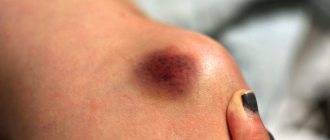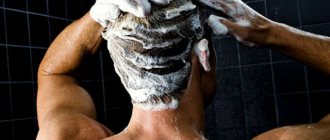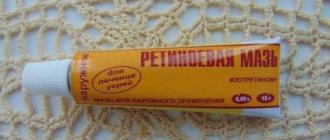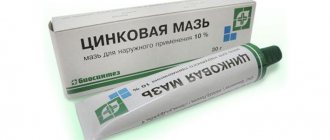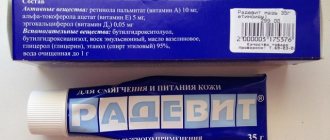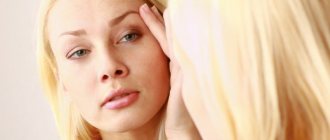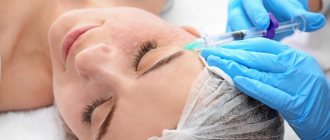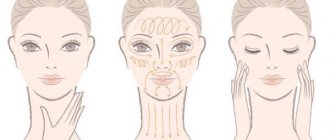Types and forms of means of different actions
The ointment is chosen depending on the stage of wound recovery. Fresh sutures after surgery are treated with antiseptic and antibacterial drugs, and regenerating agents are used at the healing stage. The doctor takes into account the presence of infections.
For purulent lesions, antibiotics are prescribed to inhibit the growth of microorganisms.
Types of medications depending on pharmacological action:
- Antiseptic – disinfectant preparations for the destruction of pathogenic microflora.
- Wound healing agents accelerate the process of renewal and scarring;
- Anti-inflammatory ointments eliminate the pathological process that occurs after surgery. Active substances reduce pain, relieve swelling, eliminate hyperemia of damaged tissues.
- Regenerating agents are used at the stage of epithelization; medications are used to prevent the formation of keloid scars.
- Antibacterials are prescribed for infection.
- Drying agents are used for weeping wounds after surgery.
Classification of ointments for healing according to release form:
- gels – substances with a soft, viscous consistency;
- creams - products are presented in the form of an oil or water based emulsion;
- liniments are characterized by a viscous consistency;
- pastes are determined by the content of powdery substances.
Review of the best gels and ointments
Before using topical products, you should carefully study the instructions. During pregnancy and lactation, contraindications for use are possible. The gel for wound healing after surgery is prescribed by the doctor, taking into account the patient’s characteristics: the presence of an allergic reaction to the components of the drug, individual intolerance.
| Name of ointment | Properties | Effect |
| Levomekol | Antibacterial, antimicrobial, anti-inflammatory | Suppressing the growth of microbes in the wound, speeds up the healing process by cleansing the pathological cavity after surgery |
| Solcoseryl | Regenerating, drying | The drug is made from the blood of dairy calves. Stimulates collagen fibers, accelerates metabolism, improves oxygen transport to cells in a state of hypoxia |
| Baneocin | Antibacterial, drying | The ointment contains neomycin, bacitracin. Used in the presence of bacteria that have entered the wound after surgery. Accelerates the healing process of soft tissues |
| Povidone-Iodine | Antiseptic, anti-inflammatory, bactericidal | When the substance is applied, iodamines are formed, which contribute to the death of pathogenic microorganisms |
| Actovegin | Regenerating | Gel for rapid and effective wound healing after various operations is indicated for the treatment of infected injuries and bedsores. Accelerates the process of glucose production, oxygen supply, improves soft tissue restoration |
| Argosulfan | Antibacterial | Ointment with silver ions. The active substance suppresses the growth of bacterial infection, eliminates pain, accelerates epithalization |
| Bepanten | Anti-inflammatory, regenerating | Dexpanthenol is converted to pantothenic acid when it enters a wound. Accelerates the process of scarring and healing |
| Heparin ointment | Painkillers, anti-inflammatory | The use of the product prevents the formation of blood clots. Used to remove stitches after surgery to remove hemorrhoids or rectal fissures |
| Ichthyol ointment | Antiseptic, anti-inflammatory, painkillers | Upon contact with the skin, it causes slight irritation of nerve endings and a decrease in sensitivity occurs, which is due to altered tissue trophism after surgery. Pulls out pus |
| Eplan | Antibacterial, anti-inflammatory, regenerating, antipruritic | Healing ointment for open wounds after surgery reduces pain and eliminates tissue swelling |
| Contractubex | Antithrombic, keratolytic | Accelerates cellular regeneration without the development of hyperplasia. Provides tightening of postoperative scars of any type |
| Vishnevsky ointment | Antiseptic, anti-inflammatory, antiseptic | The medication is effective for infected wounds, draws out pus, disinfects the cavity, promotes healing |
Medicines are characterized by side effects; drugs are used as prescribed by a doctor. The specialist will adjust the therapy, taking into account the nature of the wounds and the location of the injury.
The effectiveness of ointments for postoperative sutures
The rate of healing of postoperative sutures is influenced by a number of factors:
- Age . In younger patients, the healing process occurs at a faster pace.
- Weight . The presence of excess subcutaneous fat contributes to poor circulation, which leads to prolonged healing.
- Diet . Unbalanced nutrition and lack of fluid reduces the rate of tissue regeneration.
- Immunity . Disturbances in the functioning of the immune system negatively affect the healing process of postoperative wounds.
- Level of blood circulation at the wound site . Incisions located in areas with large concentrations of blood vessels heal faster.
- Oxygen supply . Tissue ischemia resulting from strong tightening of sutures, hypoxemia, low blood pressure or vascular insufficiency impairs the supply of oxygen to tissues and, as a result, prevents rapid wound healing.
- Presence of chronic diseases . Diseases of the endocrine system and diabetes mellitus have the worst effect on the healing of sutures and often contribute to the occurrence of complications.
- Suppuration or secondary infection . These problems lead to deterioration of the wound and inhibit the healing process.
- Type of scar . Normotrophic, atrophic, hypertrophic and keloid scars are distinguished. The scars of the first two groups heal the fastest.
Diseases of the endocrine system affect the rate of healing of sutures
With regular treatment, the healing time depends on the location of the wound:
- on the face – 3–5 days;
- on the stomach – 7–13 days;
- on the back – 10–20 days;
- on arms and legs – from 6 days.
The use of anti-inflammatory drugs in the first days after surgery, the use of steroid and corticosteroid drugs, chemotherapy or X-ray irradiation also significantly slow down the healing of sutures.
Instructions for using ointments
The course of treatment depends on the size of the damage and the presence of concomitant diseases. For speedy healing after surgery, it is necessary to take into account the stage of injury recovery. To achieve results, you must follow the rules of asepsis to avoid infection.
| Name of ointment | Well | Dosage | Method of application |
| Levomekol | Up to 7 days | 1-2 times a day | Apply to skin or a piece of gauze. For deep purulent wounds, the drug is administered using a syringe into the pathological cavity |
| Solcoseryl | Up to 1 month | The gel is used 2-3 times a day. Ointment – 1-2 times a day | Apply evenly to the damaged area. To speed up the healing process after surgery, you need to follow good personal hygiene |
| Baneocin | No more than 10 days | 2-3 times a day | Apply to skin under a bandage |
| Povidone-Iodine | 7-14 days | 1-2 times a day | When treating purulent wounds that arise after surgery, the ointment should be evenly distributed. To prevent bacteria from entering, the area should be covered with a sterile bandage. |
| Actovegin | Up to 12 days | 2-3 times a day | Apply a thin layer to the damaged surface. To speed up healing, it is necessary to follow the rules of asepsis after surgery. |
| Argosulfan | Up to 2 months | 2-3 times a day | Distribute a thin layer of ointment and leave until completely absorbed. Cover the wound with a bandage |
| Bepanten | As prescribed by a doctor | 3 times a day | Apply to the edges of the damage |
| Eplan | Up to 2 months | 1-2 times a day | Distribute the ointment evenly. To avoid infection, you should use sterile gloves and cotton swabs. Maintaining good hygiene promotes wound healing after surgery |
| Ichthyol ointment | As prescribed by a doctor | 1-2 times a day | Apply a thin layer, do not rub. The pathological area must be covered with a bandage |
| Heparin ointment | 1 Week | 2-3 times a day | Rub into skin until completely absorbed. To speed up healing, you must follow the instructions of your doctor after surgery. |
| Contractubex | Up to 6 months | 2-3 times a day | Apply a thin layer to open wound |
| Balsamic liniment according to Vishnevsky | As prescribed by a doctor | 1-2 times a day | Distribute a thick layer of the product, cover the pathological area with a bandage. To speed up healing, doctors prescribe the necessary medications that inhibit the growth of microorganisms |
Top 10 drugs from the pharmacy
Healing ointments for the skin of the face and other parts of the body are sold in the pharmacy chain. There are many drugs in this group. But there are means that are especially popular. That is, they are often prescribed by doctors or people purchase them on their own.
Top healing ointments:
- Bepanten.
- Levosin.
- Oflomelid.
- Levomekol.
- Stellanin.
- Baneocin.
- Propolis.
- Beloderm.
- Solcoseryl.
- Zinc ointment.
Bepanten
The main component of the ointment is dexpanthenol.
The product is recommended for use in the following cases:
- dry skin (as prevention and treatment);
- baby skin care;
- as care for the mammary glands of a nursing mother;
- burns;
- abrasions;
- skin irritations;
- chronic ulcers;
- bedsores;
- cracks;
- after skin grafting.
It is recommended to apply the product up to 2 times a day. Light rubbing of the ointment is allowed. Contraindications to the use of the drug include high sensitivity to the composition. A side effect after using the medication is an allergic reaction. The cost of Bepanten varies from 370 to 700 rubles, it all depends on the volume of the product.
Levosin
The healing ointment has a combined composition. It has antimicrobial, anti-inflammatory, necrolytic effects.
Ointment for the skin of the face and other parts of the body consists of:
- chloramphenicol;
- sulfadimethoxine;
- methyluracil;
- trimecaine;
- polyethylene oxide.
It is recommended to use Levosin for purulent lesions, long-term non-healing wounds, and burns. The use of the drug is prohibited in case of high sensitivity to the composition. As a side effect, allergies may occur after using the medication.
The ointment should be applied to a sterile gauze pad. Then the compress is applied to the affected area of the skin. The napkin is replaced with a new one every 24 hours. The cost of the drug is up to 100 rubles.
Oflomelid
The product contains ofloxacin, methyluracil and lidocaine. It also contains excipients.
The ointment is a combination ointment and has the following actions:
- antimicrobial;
- anti-inflammatory;
- anesthetic;
- regenerating.
Oflomelid is recommended for use in case of damage to the skin (burns, bedsores, ulcers). Side effects include allergies.
It is prohibited to use the product in the following cases:
- lactation;
- age category up to 18 years;
- pregnancy;
- high sensitivity to the composition.
It is recommended to apply the product once a day. Duration of use is from 7 to 14 days. It is prohibited to apply more than 100 g of product per day. The ointment can be used for wounds and burns. If the lesion is purulent, then it is necessary to apply a compress. The cost of Oflomelid varies from 120 to 400 rubles, it all depends on the volume.
Levomekol
The medication contains chloramphenicol and methyluracil. It also contains auxiliary components. Lekomekol is recommended for use in cases of skin lesions (purulent wounds). The ointment is applied to a sterile gauze pad and applied to the site of injury. The compress must be replaced with a new one every 24 hours.
Side effects include skin rashes. The product should not be used by children under 1 year of age, as well as those with hypersensitivity to the components.
The cost of the drug varies from 90 to 120 rubles.
Stellanin
The product contains diethylbenzimidazolium triiodide.
Various skin lesions can be identified as contraindications for use:
- ulcers;
- burns;
- bedsores;
- abrasions;
- cuts;
- cracks;
- scratching (this includes insect bites);
- skin grafting;
- as an additional remedy for the treatment of wounds after surgical interventions.
The ointment must be applied to the skin so that the affected area is completely covered with the product. You should not use more than 10 g of Stellanin per day. Allergies are identified as side effects.
Contraindications to the use of the product:
- simultaneous use of radioactive iodine;
- age category up to 18 years;
- pregnancy;
- lactation;
- high sensitivity to components.
The cost of the product is from 350 to 420 rubles.
Baneocin
The medicine contains bacitracin and neomycin. Baneocin is recommended for use for skin lesions, as a prophylaxis and treatment of infections after surgical operations.
Most often, the drug is well tolerated, but after use, the following side effects may occur:
- allergic reaction;
- hearing impairment;
- kidney damage;
- neuromuscular blockade.
Contraindications to the use of the drug:
- increased sensitivity to components;
- the skin is extensively affected - use is prohibited due to the effect of the drug on hearing;
- problems with urine flow;
- infection of the external auditory canal.
The ointment is used up to 3 times a day. It is possible to apply a compress to the affected area. The cost of Baneocin varies from 170 to 410 rubles.
Propolis
The composition contains propolis, so the ointment has a characteristic odor. Excipient: Vaseline. The product is recommended for use when the skin is damaged.
The ointment must be applied up to 2 times a day. The duration of treatment is from 7 to 14 days. Allergies are identified as side effects. Do not use the product if you are highly sensitive to the composition. The cost of the ointment does not exceed 100 rubles.
Beloderm
Healing ointments for the skin of the face and other parts of the body include a product called Beloderm. The drug consists of betamethasone dipropionate. Almond oil and petroleum jelly are used as excipients.
Beloderm is used externally in the following cases:
- dermatosis;
- eczema of various types;
- diaper rash;
- psoriasis;
- skin itching.
The ointment should be applied to the skin 2 to 6 times a day. This dosage should be used until improvement occurs. Then the amount is reduced to 1 - 2 times a day.
If Beloderm is used for children or on the face, the duration should not exceed 5 days.
Side effects include an allergic reaction and the occurrence of a secondary infection. The ointment is not recommended for use if you are highly sensitive to the components. The cost of the ointment varies from 180 to 300 rubles, it all depends on the volume.
Solcoseryl
The product consists of deproteinized dialysate, which is obtained from the blood of healthy dairy calves.
The drug is used for:
- skin damage;
- burns;
- frostbite;
- wounds that are difficult to heal;
- trophic tissue lesions (before use, dead tissue must be removed from the wound).
Before using the ointment, the surface of the skin must be treated with a disinfectant solution. It is recommended to use the product 2 – 3 times a day. It is allowed to apply Solcoseryl ointment on a sterile gauze pad and apply it to the affected area. The product must be used until the skin is completely healed.
An allergic reaction is identified as a side effect. After using Solcoseryl, a burning sensation may be felt, but it goes away on its own. But if the symptom remains, use should be stopped.
Do not use the product if you are hypersensitive to the components.
The cost of the drug is from 270 to 650 rubles.
Zinc ointment
The ointment contains zinc oxide and petroleum jelly (an excipient).
It is recommended to use the product for various skin lesions, namely:
- rash;
- diaper rash;
- ulcer;
- eczema;
- herpes;
- burns;
- bedsores.
The product is applied to the affected area up to 2 times a day. An allergic reaction is identified as a side effect. Zinc ointment is not recommended for use if you are hypersensitive to the components. The cost of the drug varies, but does not exceed 100 rubles. It all depends on the manufacturer and volume.
For various lesions of the skin, it is recommended to use healing ointments. The pharmacy chain offers many such drugs. They can be used on the face and other parts of the body.
Of the 10 top drugs that are most often purchased at pharmacies, it is impossible to single out just one product. Medicines have different components. Therefore, if the skin is affected, it is best to consult a dermatologist to prescribe the drug.
Article design: Vladimir the Great
